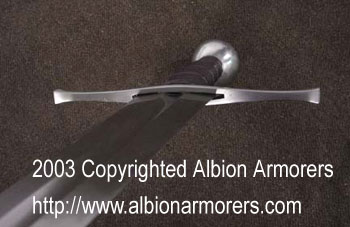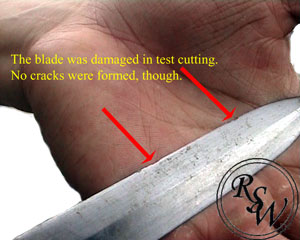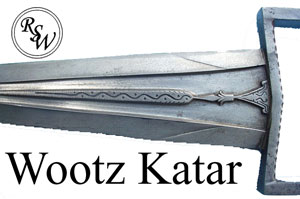

- Freestyle fencing with the historical arsenal
- Swords Usage
- Swords Architecture
- Other Historical Weaponry
- Photo Album
Sword Architecture
-
Despite public belief, the broader the blade doesn't equal to the heavier the sword and the narrower the blade doesn't equal to the lighter the sword either. This misconception was formed when people look at the sword through 2-dimensions photos and haven't inspected their thickness. Actually, the narrower the blade, the thicker it is. On contrary, the broader the blade, the thinner it is.

 |
|


-
It takes only 1 crack to end a sword's life. After a crack is formed, it breaks the microstructure in the blade upon each contact and soon the blade will break at the line behind the crack. So many swords did not last more than a battle.

-
The wavy line visible on a Japanese Katana is called "Hamon". It's the differentiation area between the martensite steel structure at the edge and the pearlite steel structure at the sides and spine. Martensite structure is hard but brittle that's good for keeping the edge sharp, while pearlite structure is soft but tough that's good to absorb shocking power during strikes. Different styles of smith school favor different "Hamon" patterns. Usually during wartime, the "Hamon" were straight and simple because of the urgency. However, the better "Hamon" patterns come with many semi-circle so that in case the edge suffers damage, it chips off in semi-circle shape and does not form a sharp angle crack that will jeopardize the blade's integrity.
-
Despite the use of Wootz steel (true Damascus steel) in the middle east region, European swords were sought after by Arabian nobles and other inhabitants of the area. It was also sought after in Japan after the connection had been established since 16th century. Although European swords were designed to have softer edges than Japanese and Wootz swords, they were tough and reliable even under the most difficult situation because they were made to survive the extreme cold weather where steel would become brittle. Moreover, the ore in Europe were good.

-
A sharper sword is not always better. The sharper a sword is, the more prone to damage it is. A sword has to be sharp, but it cannot risk developing a crack upon the first few contact by going overly sharp. Some 10th century Viking antique swords are sharp enough to cut paper when they were rediscovered. On the other hand, some battlefield Katana was blunt enough to be taken as a steel rod. The reason behind is that Viking sword fighting style involves the use of shield and the sword did not have to parry incoming attacks, so it can stay as sharp as possible. However, Katana were used without a shield and to survive the contact, its edge has to be thicker.